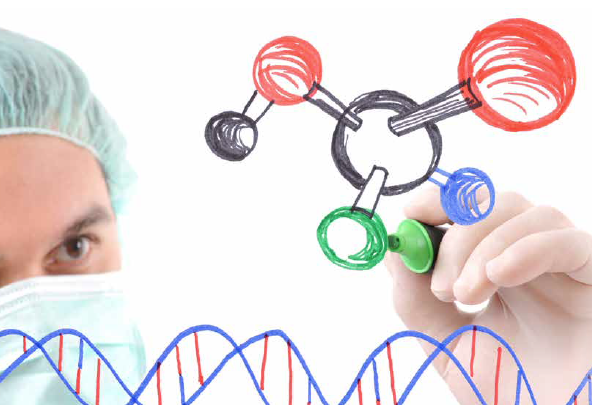 For most cancers, diagnosis happens too late, when the cancer has worsened or metastasized. But when cancers are diagnosed early, survival statistics are much higher. For example, the five-year survival rate for patients diagnosed with colorectal cancer is around 90% if diagnosed when the cancer is at early and local stage, dropping as low as 12% once it reaches late or distant stage, according to the American Cancer Society.
For most cancers, diagnosis happens too late, when the cancer has worsened or metastasized. But when cancers are diagnosed early, survival statistics are much higher. For example, the five-year survival rate for patients diagnosed with colorectal cancer is around 90% if diagnosed when the cancer is at early and local stage, dropping as low as 12% once it reaches late or distant stage, according to the American Cancer Society.
Next-generation sequencing and bioinformatic data analysis have enabled research into the human genome and into the genomes of some cancers. Industry leaders say 15 to 20 years from now, there will be a battery of genes tests that will predict with higher probability the chances of someone developing cancer. Physicians will be able to guide patients in disease prevention in the same way that metabolic disease is approached today.
“If someone has high cholesterol, a doctor can prescribe very early on in the progression of the disease a different lifestyle or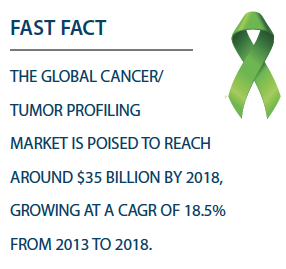 give the patient medication," says Aaron Bensimon, Ph.D., CEO, president, and co-founder, of Genomic Vision. “This intervention can prevent the person from dying of heart disease. In the future, it will be the same for genetic diseases.
give the patient medication," says Aaron Bensimon, Ph.D., CEO, president, and co-founder, of Genomic Vision. “This intervention can prevent the person from dying of heart disease. In the future, it will be the same for genetic diseases.
“If we have the tools to detect genetic changes that occur during the lifetime of the cell and can correlate those changes to cancer progression, then we’ll have the tools to fight cancer," he adds.
Recent research has identified the role of epigenetics, the switching on and off of genes, in cancer. Diagnostics companies are using this research to find new ways to identify cancers at their earliest stage.
Using genetic and epigenetic markers, the promise of genetic testing for cancer can come true, says Jake Micallef, Ph.D., chief scientific officer, VolitionRx.
“With a combination of epigenetic and genetic markers, we will be able to detect cancers much earlier than we do now," he says.
Genomic tests for cancer have been used for some time, what is now new, Dr. Micallef says, is that researchers are working to develop genomic tests that work with blood samples.
“We understand much more about circulating tumor DNA, where it comes from, and what it looks like," he says. “One of the things that is most interesting for me is that researchers have found that there are all sorts of DNA fractions circulating in the blood, but the DNA fraction that comes from tumors bind to mono-nucleosomes. This shows that the nucleosomes we measure using our Nucleosomics technology do originate from tumor cells."
Additionally, understanding the relationship between the tumor and its microenvironment is very important for determining a cancer’s aggressiveness, says Oscar Bronsther, M.D., CEO of MetaStat.
“While we continue to look for better biomarkers, evolve next-generation sequencing, and rely on genomics and protoeomics, there will be a focus on epigenetics, which represents a new wave of understanding cancer biology," he says. “Epigenetics provides more actionable information so oncologists can figure out better ways to diagnose and treat cancer."
The field of clinical genomics is growing and evolving very quickly as more and more researchers grasp the potential. The global cancer/tumor profiling market is poised to reach around $35 billion by 2018, growing at a CAGR of 18.5% from 2013 to 2018, according to MarketsandMarkets.
Moving forward, one of the biggest challenges for genomics-based diagnostics will be payer and reimbursement issues, says Jan Groen, CEO of MDxHealth.
“Our industry continues to struggle with what the value should be for a test that predicts how a patient will respond to a cancer treatment," he says. “A shift is taking place, as the healthcare industry transitions from volume-based medicine to value-based medicine, we will see more molecular diagnostic tests coming to the market. Fortunately, a handful of these tests, like our ConfirmMDx test that can aid in reducing unnecessary and expensive procedures, are already being reimbursed by payers. A key to the successful realization of personalized medicine will not only be the use of next-generation sequencing to identify powerful biomarkers that improve the detection and treatment of cancer, but importantly demonstrating that these assays improve patient outcomes and reduce the cost of care."
MDxHealth, a molecular diagnostics company that develops and commercializes epigenetic tests to support cancer treatment, has a technology platform called MSP (Methylation-Specific-PCR), which is a proprietary DNA-based process that functions on standard commercial PCR equipment.
A May 2012 report from the Institutes of Medicine, stemming from a roundtable on medical technology policy and molecular diagnostics in oncology, found that a major limiting factor for the use of molecular diagnostics tests has been the lack of clear evidence of clinical utility. The workshop brought together a wide range of stakeholders, including patients, healthcare providers, policy makers, payers, diagnostic test developers, researchers, and guideline developers to identify the challenges and opportunities in advancing the development and use of molecular diagnostic tests.
The Centers for Medicare & Medicaid Services’ guidelines for the evaluation of diagnostics tests center on two questions. First, is the evidence adequate to determine whether the test provides accurate diagnostic information? Second, if the test changes accuracy, is the evidence adequate to determine how the changed accuracy affects health outcomes?
Industry leaders note the CMS criteria point to the fact that diagnostic accuracy by itself is not enough to establish value. The important factor is whether test results lead to changes in practice that can be linked to improved health outcomes.
Still, diagnostic companies are moving the science forward as the knowledge of cancer biology and technology advance. Though molecular diagnostics currently apply to only about 2% of the population, that number could eventually rise to 60%, according to some estimates.
The MarketandMarkets report predicts the market is expected to grow, backed by technological advancements, huge funds, and investments. The market is witnessing a trend toward the development of personalized medicine and point-of-care diagnostic tests for cancer. Additionally, the demand for safe and cost-effective drugs for the treatment of cancer — which can be fulfilled by cancer/tumor profiling therapeutics — will fuel the market growth.
New Diagnostic Research
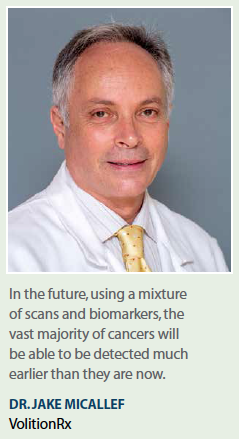 VolitionRx is developing diagnostic tests for cancer and other conditions based on the science of Nucleosomics, which is the practice of identifying and measuring nucleosomes in the bloodstream or other bodily fluid as an indication that disease is present.
VolitionRx is developing diagnostic tests for cancer and other conditions based on the science of Nucleosomics, which is the practice of identifying and measuring nucleosomes in the bloodstream or other bodily fluid as an indication that disease is present.
“Our work combines two areas of research done by thousands of oncologists and epigeneticists around the world," Dr. Micallef says. “The first shows that histone modifications are different in cancer and healthy tissues and in different cancers. The second is based on research done in Germany looking at circulating nucleosomes. When cells die, the chromosomes are chopped up into mono-nucleosomes, which are largely metabolized. But some of these end up in circulation. The level of these mono-nucleosomes is raised in cancer."
Dr. Micallef says VolitionRx is working on cancer detection tests that look at the nucleosome and altered histone modification or DNA or variant structures. The company is evaluating its tests in several clinical trials. One of which is a retrospective trial with 4,800 colorectal cancer patients in Europe.
“In addition to our 4,800-patient retrospective trial, we are following up with a 14,000-patient prospective screening trial in colorectal cancer," he says. “If results are positive, this size study will be more than adequate for a CE mark to bring the product to market in Europe. For the United States, we’ll need to do a specific U.S. trial, and realistically this is a few years away."
Dr. Micallef says an interim report of the retrospective study shows the company’s test was able to detect 84% of colorectal cancers with a specificity of 78% and 60% of polyps.
“That accuracy rate is very good for Europe, which currently uses fecal tests for diagnosis that are much less specific and sensitive," he says. “In the United States, physicians currently use colonoscopy, which is more specific and accurate but more invasive for patients."
Dr. Bensimon’s company, Genomic Vision, is developing DNA-based diagnostics for the detection of genetic disease. The company is looking at the genome via the approach of stretching and aligning DNA molecules.
“Once we have stretched the DNA we put fluorescent markers on specific regions of the genome that are suspected to have 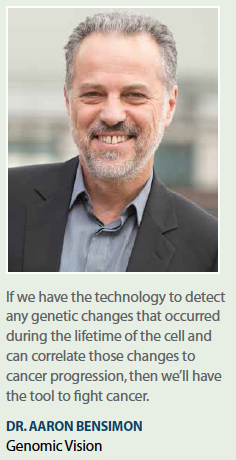 been modified and by observing the distance between those markers, we can identify genetic mutations," Dr. Bensimon says. “It’s like a barcode on a product. By scanning the barcode, we can see the price of product. We are designing barcode-like markers for different regions of the genome and if the barcode registers incorrect, this indicates a genetic disease."
been modified and by observing the distance between those markers, we can identify genetic mutations," Dr. Bensimon says. “It’s like a barcode on a product. By scanning the barcode, we can see the price of product. We are designing barcode-like markers for different regions of the genome and if the barcode registers incorrect, this indicates a genetic disease."
The company’s first test is for detecting Facio-scapulo-humeral muscular dystrophy (FSHD). The test provides a precise measurement of the D4Z4 repeats on chromosome 4 and 10. It was launched in Europe by Genomic Vision and in the United States through Quest Diagnostics in 2013.
At the end of July 2014, Genomic Vision validated the diagnostic test for Lynch Syndrome (HNPCC, or hereditary non-polyposis colorectal cancer), which makes it possible to visualize all of the five major genes involved in this disease. The company also validated, with Quest Diagnostics, a new protocol for the Genomic Morse Code for its tests for breast and ovarian cancer (BRCA) and Lynch Syndrome, and launched the production of the high-throughput scanner’s pilot instruments. The company also is working on a test for HPV cervical cancer.
Determining Metastases
Other companies, such as MetaStat, are developing epigenetic-based diagnostics to identify the likelihood of metastases. The company’s platform is built on the identification and understanding of the tumor microenvironment and role of the Mena protein and its isoforms, a common pathway for the development of systemic metastatic disease in all epithelial-based solid tumors.
“We are exploiting the biology through which metastatic disease arises," Dr. Bronsther says. “There is an embryonic protein called Mena, which in utero participates in the maturation of the central and peripheral nervous system. Postpartum expression of Mena is suppressed in healthy human beings. There is a modest amount of Mena that persists, but in all epithelial-based cancers, the gene that codes for Mena is turned back on."
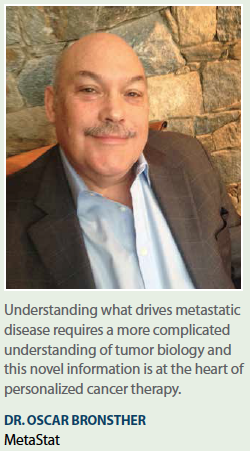 Dr. Bronsther says Mena is actually a family of proteins with five different isoforms. MetaStat is focused on two of them. One is Mena 11A, an antimetastatic form of Mena. It increases the adhesions between cancer cells and prevents individual cancer cells from detaching from the primary tumor and migrating toward the blood that surrounds the tumor. The second focus is on Mena INV (invasive), which is the prometastatic form of Mena. It enables individual cancer cells to detach from the primary tumor, change its shape and dramatically upregulate the sensitivity of the growth factor receptors on the cell surface.
Dr. Bronsther says Mena is actually a family of proteins with five different isoforms. MetaStat is focused on two of them. One is Mena 11A, an antimetastatic form of Mena. It increases the adhesions between cancer cells and prevents individual cancer cells from detaching from the primary tumor and migrating toward the blood that surrounds the tumor. The second focus is on Mena INV (invasive), which is the prometastatic form of Mena. It enables individual cancer cells to detach from the primary tumor, change its shape and dramatically upregulate the sensitivity of the growth factor receptors on the cell surface.
The company’s near-term project is in breast cancer and the MetaSite Breast test aims to detect which breast cancers are likely to metastasize.
“The question that we are attempting to address in the breast cancer space is whether a woman with newly diagnosed breast cancer should receive adjuvant chemotherapy in an attempt to prevent the disease from metastasizing in the future," Dr. Bronsther says. “This is an important question because, historically in America, the overwhelming majority of women with newly diagnosed breast cancer will get adjuvant chemotherapy. This is unfortunate because even if left untreated, only 35% of these women would ever go on to develop metastatic disease. All tumors are not biologically created equal. In fact, only a percentage of any tumor has metastatic potential."
Dr. Bronsther says the underlying biology of these tumors determines the outcome much more than when the tumor is detected.
The company has two different diagnostics, both of which exploit Mena biology. Dr. Bronsther says the company has identified the portal through which these individual breast cancer cells enter the blood vessels that surround the tumor.
“This portal is a three-cell structure, which is a cancer cell expressing the Mena protein, a blood vessel cell called the endothelial cell, and a special white cell called a perivascular macrophage," he says. “This micro-anatomical structure had been called a TMEM, a tumor microenvironment for metastases. We renamed this three-cell structure the ‘MetaSite.’ We quantify and count the number of these three-cell structures and the more of these structures present on the slide, the more likely the woman is to develop metastatic disease; and the fewer, the less likely."
 The company’s second diagnostic is MenaCalc, its platform technology, which looks at the ratio of the tissue using quantitative immunofluorescence of the different Mena isoforms. The more Mena INV that is expressed, the more aggressive the tumors are.
The company’s second diagnostic is MenaCalc, its platform technology, which looks at the ratio of the tissue using quantitative immunofluorescence of the different Mena isoforms. The more Mena INV that is expressed, the more aggressive the tumors are.
Developing Better Treatments
Once a diagnosis is made, the gene expression profile of the cancer allows researchers to help design the best therapy, says Deny Miller, global therapeutic head oncology/hematology, Parexel.
“Any biochemical or genomic tests that can give us an earlier way to diagnose cancer is going to be important," he says. “Early detection will minimize the severity and adverse effects of treatment. We need more exact biological diagnostics to pick up the specific abnormalities of cancer and make an early diagnosis to improve the likelihood of a cure. Molecular diagnostic studies and gene expression profiling studies help to identify a number of mutations that may occur that are driving the cancer process. Many of those mutations are in receptors that control the growth rate and rate of cell division. We are now identifying different types of therapies from all of these different mutations that may occur at the time of diagnosis or may occur after a patient has had treatment and new mutations occur. So we can make our treatments much more specific than the shotgun approach of chemotherapy." (PV)


















